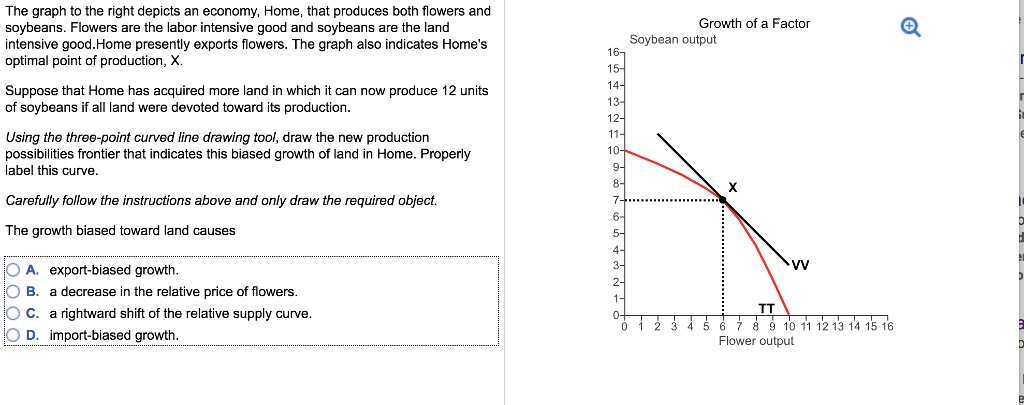The graph to the right depicts an economy, Home, that produces both flowers and soybeans. Flowers are the labor intensive good and soybeans are the land intensive good.Home presently exports flowers. The graph also indicates Home's optimal point of production, X. Suppose that Home has acquired more land in which it can now produce 12 units of soybeans if all land were devoted toward its production. Using the three-point curved line drawing tool, draw the new production possibilities frontier that indicates this biased growth of land in Home. Properly label this curve. Carefully follow the instructions above and only draw the required object. The growth biased toward land causes
The graph to the right depicts an economy, Home, that produces both flowers and soybeans. Flowers are the labor intensive good and soybeans are the land intensive good.Home presently exports flowers. The graph also indicates Home's optimal point of production, X. Suppose that Home has acquired more land in which it can now produce 12 units of soybeans if all land were devoted toward its production. Using the three-point curved line drawing tool, draw the new production possibilities frontier that indicates this biased growth of land in Home. Properly label this curve. Carefully follow the instructions above and only draw the required object. The growth biased toward land causes
Chapter1: The Role And Method Of Economics
Section: Chapter Questions
Problem 8P
Related questions
Question

Transcribed Image Text:The graph to the right depicts an economy, Home, that produces both flowers and
soybeans. Flowers are the labor intensive good and soybeans are the land
intensive good. Home presently exports flowers. The graph also indicates Home's
optimal point of production, X.
Suppose that Home has acquired more land in which it can now produce 12 units
of soybeans if all land were devoted toward its production.
Using the three-point curved line drawing tool, draw the new production
possibilities frontier that indicates this biased growth of land in Home. Properly
label this curve.
Carefully follow the instructions above and only draw the required object.
The growth biased toward land causes
OA. export-biased growth.
O B. a decrease in the relative price of flowers.
OC. a rightward shift of the relative supply curve.
O D. import-biased growth.
16-
15-
14-
13-
12-
11-
10-
9-
7-
6-
5-
Growth of a Factor
Soybean output
VV
TT
7 8 9 10 11 12 13 14 15 16
Flower output
€
Expert Solution
This question has been solved!
Explore an expertly crafted, step-by-step solution for a thorough understanding of key concepts.
Step by step
Solved in 3 steps with 1 images

Knowledge Booster
Learn more about
Need a deep-dive on the concept behind this application? Look no further. Learn more about this topic, economics and related others by exploring similar questions and additional content below.Recommended textbooks for you

Exploring Economics
Economics
ISBN:
9781544336329
Author:
Robert L. Sexton
Publisher:
SAGE Publications, Inc

Brief Principles of Macroeconomics (MindTap Cours…
Economics
ISBN:
9781337091985
Author:
N. Gregory Mankiw
Publisher:
Cengage Learning


Exploring Economics
Economics
ISBN:
9781544336329
Author:
Robert L. Sexton
Publisher:
SAGE Publications, Inc

Brief Principles of Macroeconomics (MindTap Cours…
Economics
ISBN:
9781337091985
Author:
N. Gregory Mankiw
Publisher:
Cengage Learning



Economics Today and Tomorrow, Student Edition
Economics
ISBN:
9780078747663
Author:
McGraw-Hill
Publisher:
Glencoe/McGraw-Hill School Pub Co

Economics (MindTap Course List)
Economics
ISBN:
9781337617383
Author:
Roger A. Arnold
Publisher:
Cengage Learning